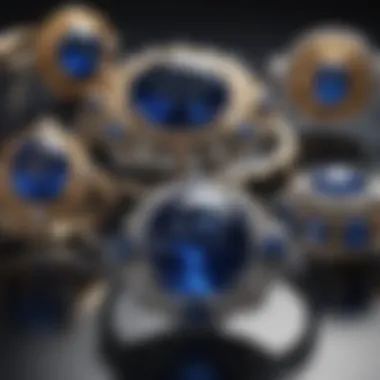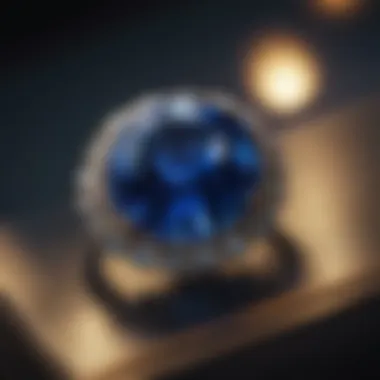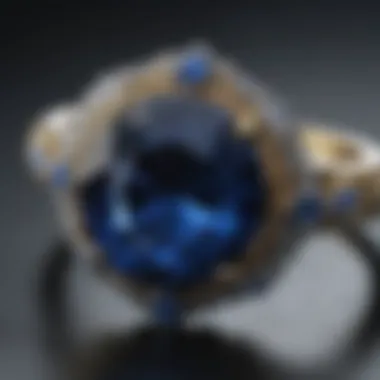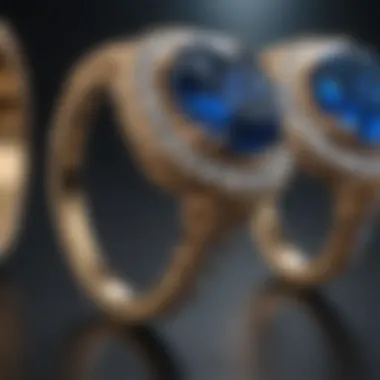The Comprehensive Guide to Wholesale Sapphire Jewelry


Intro
The world of wholesale sapphire jewelry offers a unique blend of beauty and investment value. For gemstone enthusiasts, collectors, and professionals alike, understanding this niche market is crucial. As sapphires garner attention for their stunning appearance and variety, this guide provides a comprehensive look at their characteristics, historical significance, and the intricate dynamics of the wholesale sector.
By arming oneself with knowledge about both the gemstones themselves and the supply chain they navigate, interested parties can enhance their experience and decision-making processes. This exploration is not merely about purchasing jewelry; it encompasses understanding market trends, discerning quality, and appreciating the cultural heritage surrounding sapphires.
Gemstone Overview
Definition and Characteristics
Sapphires are varieties of the mineral corundum, primarily recognized for their rich blue hues. However, they can occur in a spectrum of colors. Their color is due to trace elements like iron, titanium, and chromium.
The most valued sapphires are often those that display a deep, vivid blue. Notably, sapphires possess remarkable hardness, rating a 9 on the Mohs scale. This makes them ideal for everyday wear, especially in rings and bracelets.
Sapphires exhibit unique clarity and transparency but can have inclusions that affect their beauty. Jewelers often use terms like 'silk' to describe certain inclusions that can enhance a stone's appearance by creating a subtle glow known as asterism. The clarity and color intensity of a sapphire greatly impact its market value.
Classification of Gemstones
Sapphires fit within the category of precious gemstones, which includes diamonds, rubies, and emeralds. These gems are classified based on several factors:
- Natural: Formed through natural geological processes.
- Synthetic: Man-made stones with the same physical and chemical properties as natural sapphires.
- Treated: Natural sapphires that undergo treatments to enhance their appearance, such as heating or filling.
Understanding these classifications is essential for buyers, as the value and quality can differ significantly among them. Buyers are encouraged to ask about the origin and treatment of the stones they are considering for purchase.
Historical Significance
Ancient Uses and Cultural Importance
Sapphires have been cherished for centuries, dating back to ancient civilizations. They have been used in jewelry worn by royalty, often believed to confer protection and divine favor. Various cultures prized sapphires for their supposed powers: protection against evil, loyalty, and wisdom.
In the Middle Ages, clergy wore sapphires to symbolize heaven, while the stone was also thought to attract blessings and bring peace of mind. The enduring allure of sapphires is evident in their continuous use throughout human history.
Myths and Legends Surrounding Gemstones
Various myths and legends heighten the mystique surrounding sapphires. Stories suggest that these gems bring prosperity and safeguard their owners. In some cultures, wearing a sapphire is believed to foster communication and harmony in relationships.
"Sapphires are said to inspire respect and loyalty among friends and partners."
As sapphire jewelry continues to capture attention, understanding these legends can enhance one's appreciation for the gemstones. The duality of tangible beauty and intangible meaning elevates their significance in both personal and cultural contexts.
Understanding Sapphire Jewelry
Understanding sapphire jewelry is crucial for anyone engaged in the wholesale market or simply looking to appreciate these gemstones. Sapphires are more than just beautiful stones; they have a rich history, diverse varieties, and distinctive qualities that make them valuable in various contexts—be it personal adornment or commercial trade. This knowledge not only informs purchasing decisions but also enhances the appreciation of these gems as art forms.
Defining Sapphire and Its Varieties
Sapphire is a precious gemstone belonging to the corundum family. While many associate sapphires with their classic blue hue, they actually come in a range of colors, except red. This brings us to their varietals.
The most notable varieties include:
- Blue Sapphire: Perhaps the most recognized, prized for its vivid blues.
- Padparadscha: A rare hue that blends pink and orange.
- Yellow Sapphire: Bright and cheerful, often linked with good fortune.
- Green Sapphire: Captivating with its earthy allure.
- Pink Sapphire: Increasingly sought after for its romantic shades.
The value of each sapphire type can differ significantly based on aspects like color, clarity, and origin. Understanding these varieties provides insight into the broader sapphire market, helping prospective buyers to understand what they are investing in.


The Historical Significance of Sapphires
Sapphires have held historical significance across cultures. Their allure extends back to ancient civilizations where they were believed to possess protective and divine qualities. In medieval Europe, they were considered symbols of power and wisdom, often worn by royalty.
Sapphires have adorned crown jewels and have been linked to various legends and folklore, which enhances their desirability. In modern contexts, they are not only seen in royal jewels but also in engagement rings, symbolizing commitment and trust. This deep-rooted history plays a crucial role in defining the market value of sapphires today. Understanding this significance can facilitate better purchasing decisions, backed by both emotional and financial insight.
"The inherent beauty and long-standing history of sapphire jewelry can transform a purchase into a meaningful investment."
The Wholesale Sapphire Market
The wholesale sapphire market plays a pivotal role in the overall gemstone economy. This sector enables retailers, jewelers, and designers to acquire sapphires more efficiently and at lower prices than traditional retail methods. It connects producers, often resource-rich nations, with businesses looking to sell high-quality sapphire jewelry to customers. By understanding this market, stakeholders can navigate challenges and seize opportunities effectively.
Overview of the Wholesale Gemstone Industry
The wholesale gemstone industry encompasses a wide range of gemstones, with sapphire being one of its key players. This industry serves as the backbone for gemstone supply, acting as a bridge between miners and retailers. Suppliers source sapphires from various locations such as Sri Lanka, Kashmir, and Madagascar. Each region offers unique characteristics in terms of quality and color, affecting supply and market values.
Additionally, the wholesale market is influenced by several factors:
- Demand: Fluctuations in consumer interest can affect pricing and availability.
- Economy: Economic conditions can influence purchasing power for retailers.
- Sustainability: There is an increasing demand for ethically sourced gemstones, impacting suppliers.
In essence, this market operates on dynamics that require constant surveillance, making it important for those in the sapphire business.
Current Trends in Sapphire Sourcing
As the wholesale sapphire market evolves, several trends are emerging that stakeholders should be aware of. These trends indicate shifts in consumer preferences and sourcing practices:
- Ethical Sourcing: More consumers are prioritizing ethically sourced gemstones. This affects sourcing strategies, requiring suppliers to provide transparency in their supply chain.
- Lab-Created Sapphires: The rise in popularity of lab-created sapphires offers a more sustainable option. These stones have similar characteristics to natural sapphires and cater to a market interested in affordability and ethical concerns.
- Customization: Retailers are seeking unique and custom pieces for customers. This drives the demand for varied shapes and colors in wholesale offerings.
- Digital Platforms: Online marketplaces are becoming a common way for buyers to connect with suppliers. This trend streamlines purchasing processes and improves access to a variety of products.
It is crucial for businesses to stay informed about these trends. By doing so, they can adjust their sourcing strategies and meet consumer demands effectively.
Evaluating Quality in Sapphire Jewelry
Evaluating the quality of sapphire jewelry is a critical aspect for both wholesale buyers and sellers. Understanding the characteristics that define high-quality sapphires can lead to better purchasing decisions and increased profitability. This section will outline the key elements involved in assessing sapphire quality and how these factors can influence market behavior.
The Four Cs: Cut, Color, Clarity, Carat Weight
The Four Cs—cut, color, clarity, and carat weight—serve as the foundation for determining the quality of sapphires. Each characteristic impacts not only the appearance of the gemstone but also its value and desirability in the market.
- Cut: The cut refers to how well the sapphire has been shaped and polished. A well-executed cut enhances the gemstone’s brilliance and allows it to reflect light more effectively. Variations in cut can affect the perceived size and quality of the stone. Common cut styles for sapphires include round, oval, and cushion.
- Color: Color is arguably the most significant characteristic when assessing sapphires. The most sought-after hues are vivid blue, but sapphires can also come in shades of pink, yellow, and green. Buyers often value sapphires with deep, intense colors over lighter variants. The presence of secondary hues can also impact the overall quality classification.
- Clarity: This relates to the presence of inclusions or blemishes within the sapphire. A higher clarity grade indicates fewer visible imperfections, often leading to greater value. However, some inclusions can add uniqueness, affecting market dynamics.
- Carat Weight: This measures the weight of the sapphire, directly correlating with size. Larger sapphires are generally rarer and more valuable, although other factors like color and clarity also play a crucial role in the stone's overall worth.
"When buying sapphire jewelry, understanding the Four Cs can dramatically influence the purchase decision and outcome."
Each of these characteristics interacts in complex ways, impacting not only the beauty of the gemstone but its market price as well. A balance of high grades in all Four Cs is what most buyers seek, as it generally leads to a valuable investment.
Certification and Grading Standards
Certification and grading standards provide essential credibility in the gemstone industry. These standards ensure that buyers can trust the quality and authenticity of sapphires when purchasing wholesale.
Gemstones are often evaluated by trusted institutions such as the Gemological Institute of America (GIA) or the American Gem Society (AGS). Certifications from such organizations validate the claims made regarding the Four Cs. They typically include detailed findings that assess cut, color, clarity, and carat weight in a standardized manner.
In addition to these grades, certification can include the following:


- Origin: Knowing where the sapphire was mined can impact its value considerably. Certain locations are renowned for producing superior sapphires.
- Treatment: Many sapphires undergo treatments to enhance their appearance. Full disclosure of treatments is crucial for buyers as untreated stones often carry higher values.
By understanding and utilizing certification systems, buyers can make more informed decisions, ensuring they invest in quality sapphire jewelry. This process ultimately contributes to a more transparent wholesale market, protecting both buyers and sellers against potential fraud and misrepresentation.
Purchasing Wholesale Sapphire Jewelry
Purchasing wholesale sapphire jewelry is a critical aspect of engaging in the gemstone market. It requires a careful approach to ensure optimal decisions that benefit both buyers and sellers. Understanding the nuances of this process can enhance profitability and establish long-term business relationships. In this section, we will discuss the essential elements, benefits, and considerations when venturing into wholesale sapphire acquisitions.
Finding Reliable Wholesale Suppliers
The foundation of successful wholesale sapphire purchases begins with identifying reliable suppliers. It is essential to conduct thorough due diligence to verify the credentials and reputation of potential vendors. Look for suppliers with positive reviews, industry certifications, and a demonstrable history of providing high-quality sapphires. Networking within gemstone trade shows or utilizing platforms like reddit.com can provide insights into trustworthy suppliers. Additionally, ensure that potential partners offer a diverse range of sapphires, including different colors and qualities.
Key aspects to consider when evaluating suppliers include:
- Transparency on sourcing: Understanding where and how the sapphires are sourced can influence their market value and ethical considerations.
- Pricing structures: Some suppliers may offer tiered pricing based on volume, while others may stick to set prices.
- After-sale support: Reliable suppliers often provide assistance well after the sale, such as guidance on market trends or product care.
Establishing a solid relationship with suppliers can lead to better terms and access to exclusive products, which is a significant advantage in this competitive market.
Negotiating Prices and Terms
Negotiating prices and terms is a crucial step in the purchasing process. It requires a strategic approach to ensure that both buyer and supplier reach a mutually beneficial agreement. Be prepared to negotiate based on the quality of the sapphires, order size, and market conditions. Understanding the prevailing market prices for sapphires will empower you during negotiations.
When entering discussions:
- Have clear goals: Know your budget and expectations prior to the conversation.
- Be flexible: Sometimes, offering to increase order quantities can lead to better pricing.
- Inquire about promotions: Suppliers may have special offers or discounts that could prove beneficial.
- Get everything in writing: Always confirm pricing, delivery timelines, and return policies in a contract to avoid misunderstandings later on.
Ultimately, effective negotiation can lead to significant cost reductions and better terms, enhancing overall profitability.
Understanding Minimum Order Quantities
Understanding minimum order quantities (MOQs) is vital for both new and established buyers in the wholesale market. MOQs are the smallest number of pieces a supplier is willing to sell at wholesale prices. This information significantly impacts purchasing decisions.
Considerations regarding MOQs include:
- Investment: It is essential to assess whether the financial commitment associated with meeting an MOQ aligns with your business strategy.
- Inventory management: Buying in bulk can provide cost savings, but it also requires thoughtful inventory management to prevent overstock or dead inventory.
- Supplier flexibility: Some suppliers might be open to negotiating MOQs, especially for first-time buyers, which can open doors for smaller businesses.
Understanding MOQs and how they fit into your purchasing strategy is vital for successful wholesale engagements.
Marketing Wholesale Sapphire Jewelry
Marketing wholesale sapphire jewelry is an essential aspect of ensuring a successful business in the gemstone industry. With the increasing competition and the diverse range of products available, having a marketing strategy specifically tailored to sapphire jewelry can lead to better visibility and sales.
Understanding the unique selling points of sapphire jewelry is crucial. Factors like quality, rarity, and design variations must resonate strongly with potential buyers. A targeted marketing approach can effectively highlight these elements, thus attracting retailers who are keen on offering attractive products to their customers.
By effectively marketing sapphire jewelry, wholesalers can enjoy several benefits, such as increased brand recognition, improved customer loyalty, and expanded market reach. Additionally, it helps in clearly communicating the value proposition of sapphires, making it easier for retailers to make purchasing decisions.
Strategies for Targeting Retailers
To successfully reach retailers, wholesalers must adopt specific strategies that highlight the unique features of their sapphire jewelry. Below are effective approaches to consider:
- Build Relationships: Establishing a rapport with retailers is key to long-term success. Regular communication and personalized service can forge strong business relationships.
- Leverage Testimonials: Using testimonials from satisfied customers or established retailers can enhance credibility. Positive feedback can persuade potential retailers to stock products.
- Attend Trade Shows: Participation in trade shows allows for direct interaction with retailers. It provides a platform to showcase the quality and diversity of your sapphire jewelry.
- Provide Educational Resources: Educating retailers about the characteristics and value of sapphires can empower them to sell with confidence. Providing brochures or digital content can be helpful.


Online vs. Offline Marketing Approaches
Both online and offline marketing strategies are vital for promoting wholesale sapphire jewelry. Each has its own advantages and should be used complementarily.
- Online Marketing: Utilizing social media platforms like Facebook and Instagram can showcase the beauty of sapphire jewelry. Creating visually appealing content and engaging with followers can build a loyal online community. Additionally, having a well-optimized website improves search visibility, attracting more potential buyers. Running targeted ads can effectively reach the desired audience, enhancing lead generation.
- Offline Marketing: Traditional methods such as print ads in jewelry trade publications, and local newspapers can still be effective. Personalized outreach to potential retailers through phone calls or sending samples can create a memorable impression.
Both strategies serve distinct purposes, but their integration is crucial for maximizing outreach. A balance between online presence and offline engagement makes for a comprehensive marketing approach that can lead to sustained growth in the wholesale sapphire jewelry market.
"In today's competitive market, effective marketing is not just an option, but a necessity for wholesalers of sapphire jewelry."
Legal and Ethical Considerations
The legal and ethical considerations surrounding wholesale sapphire jewelry are critical in creating a sustainable and responsible market. These issues impact not only the reputation of businesses but also the overall health of the gemstone industry. Ensuring compliance with laws and focusing on ethical sourcing can foster customer trust and loyalty, essential elements for long-term success in a competitive marketplace.
Conflict-Free Sourcing of Sapphires
Conflict-free sourcing is a pressing concern for many consumers today. This term refers to the practice of obtaining gemstones from regions that are not impacted by conflict or human rights violations. In the case of sapphires, many buyers demand assurance that the stones they purchase do not contribute to violence or exploitation. Businesses need to develop strong relationships with suppliers who can provide verifiable information about the origins of their sapphires. This can involve tracking shipments and obtaining certifications that guarantee their products are sourced ethically.
Sourcing conflict-free sapphires not only benefits communities but also enhances a brand's image. Consumers are increasingly leaning towards brands that prioritize ethical practices, making transparency essential. Here are several key benefits of conflict-free sourcing:
- Enhanced Brand Reputation: Businesses known for ethical practices often attract more customers.
- Consumer Loyalty: Satisfied customers are likely to return and recommend the brand to others.
- Legal Compliance: Meeting regulatory requirements mitigates the risk of legal issues.
Regulatory Compliance in Gemstone Trading
Regulatory compliance is another vital aspect of the gemstone industry. Various laws govern where and how gemstones can be mined, sold, and exported. Stakeholders must be aware of local and international regulations, which can include import/export laws, environmental policies, and trade agreements. Ensuring compliance can prevent costly penalties and legal problems.
Compliance also encompasses adhering to the guidelines set forth by organizations dedicated to ethical mining practices. For instance, the Kimberley Process, while primarily focused on diamonds, sets a precedent for those seeking to implement similar frameworks for sapphire trading.
"Adhering to legal standards not only protects your business but also supports the ethical framework of the entire gemstone market."
The Future of Wholesale Sapphire Jewelry
The wholesale sapphire jewelry market is poised for transformation as new dynamics emerge. This evolution is influenced by global market conditions, changing consumer preferences, and advancements in technology. Understanding these factors is crucial for stakeholders aiming to navigate the future landscape effectively. As demand for ethically sourced and unique gemstones increases, businesses in this sector must adapt to remain relevant.
Emerging Markets and Opportunities
Emerging markets present a significant opportunity for wholesalers in the sapphire jewelry sector. Countries such as India and Vietnam are witnessing a rise in middle-class consumers interested in luxury goods. This demographic shift increases the demand for high-quality sapphire jewelry, providing a fertile ground for wholesale operations.
The online marketplace has also opened doors in numerous regions. E-commerce platforms now allow businesses to reach clientele who previously lacked access to gemstone retailers. Wholesalers must exploit these platforms, ensuring their offerings are prominently displayed and marketed effectively. In addition, partnerships with local retailers can enhance distribution, bringing sapphire jewelry to new audiences.
- Key Points on Emerging Markets:
- Growth in middle-class populations in countries like India and Vietnam.
- Increased access to online purchasing through e-commerce platforms.
- Potential partnerships with local businesses for distribution.
Technological Innovations in the Gemstone Industry
Technological advancements are reshaping the wholesale sapphire jewelry market. Enhanced gemological tools allow for more precise evaluations of sapphire quality. For example, spectroscopic analysis techniques help in identifying the origin and treatments applied to gemstones more accurately. This information is invaluable in establishing authenticity and value.
Blockchain technology is gaining traction in the industry to trace the journey of sapphires from mine to market. Such transparency builds consumer trust, especially regarding ethical sourcing. The provenance of sapphires can be documented, ensuring customers that they are purchasing conflict-free gemstones.
Additionally, 3D printing technology is revolutionizing jewelry design. Wholesalers can use this technology to create unique and customizable settings for sapphires, catering to modern consumer preferences for personalized products.
- Notable Technological Innovations:
- Advanced gemological tools for quality evaluation.
- Blockchain to ensure transparency and ethical sourcing.
- 3D printing for custom jewelry design.
"The future of wholesale sapphire jewelry lies at the intersection of market adaptability and technological advancement. Stakeholders must be proactive to harness these emerging trends."
In summary, the future of the wholesale sapphire jewelry market hinges on understanding new market opportunities and embracing technological innovations. By tapping into emerging markets and leveraging cutting-edge technology, businesses can position themselves for sustained growth in this dynamic industry.







